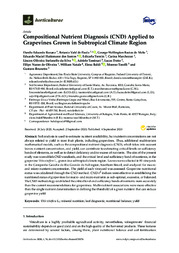Compositional nutrient diagnosis (CND) applied to grapevines grown in subtropical climate region.
Compositional nutrient diagnosis (CND) applied to grapevines grown in subtropical climate region.
Author(s): ROZANE, D. E.; PAULA, B. V. de; MELO, G. W. B. de; SANTOS, E. M. H. dos; TRENTIN, E.; MARCHEZAN, C.; SILVA, L. O. A. da; TASSINARI, A.; DOTTO, L.; OLIVEIRA, F. N. de; NATALE, W.; BALDI, E.; TOSELLI, M.; BRUNETTO, G.
Summary: Soil analysis is used to estimate nutrient availability, but nutrient concentrations are not always related to yield in most fruit plants, including grapevines. Thus, additional multivariate mathematical models, such as the compositional nutrient diagnosis (CND), which takes into account leaves nutrient concentration, and yield, can contribute to estimating critical levels or sufficiency bands of elements, as well as to detect deficiency and/or excess of nutrients. The aim of the present study was to establish CND standards, and the critical level and sufficiency band of nutrients, in the grapevine Vitis vinifera L., grown in a subtropical climate region. Leaves were collected in 81 vineyards in the Campanha Gaúcha do Rio Grande do Sul region, Southern Brazil, and analyzed for macro- and micro-nutrient concentration. The yield of each vineyard was assessed. Grapevine nutritional status was calculated through the CND method. CND-r2 indices were effective in establishing the nutritional status of grapevines for macro- and micro-nutrients as sub-optimal, excessive, or balanced. The CND methodology established the critical level and sufficiency bands of nutrients more accurately than the current recommendations for grapevines. Multi-nutrient associations were more effective than the single nutrient determination in defining the threshold of a given nutrient that can reduce grapevine yield. View Full-
Publication year: 2020
Types of publication: Journal article
Unit: Embrapa Grape & Wine
Keywords: Leaf diagnostic, Mineral nutrition, Nutritional balance, Vitis Vinifera, Yield
Observation
Some of Embrapa's publications are published as ePub files. To read them, use or download one of the following free software options to your computer or mobile device. Android: Google Play Books; IOS: iBooks; Windows and Linux: Calibre.
Access other publications
Access the Agricultural Research Database (BDPA) to consult Embrapa's full library collection and records.
Visit Embrapa Bookstore to purchase books and other publications sold by Embrapa.

